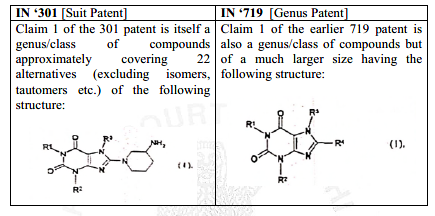Patentability of ‘Selection Inventions’ has been a hotly contested issue in India, especially in the context of pharmaceutical inventions. A selection patent is one whose subject matter (compounds or compositions) forms part of a larger known class or Markush structure of compounds which is the subject matter of a prior patent. A selection patent, referred to as species patent, has a specific coverage while the prior patent, referred to as genus patent, has a broader coverage. Recently, two decisions of the Delhi High Court have adjudicated patentability of the species patent with respect to the genus patent as part of infringement proceedings.
First, the Single Judge in Boehringer Ingelheim Pharma Gmbh v. Vee Excel Drugs and Pharmaceuticals Pvt Ltd & Ors[1], vide Order dated 29 March 2023, denied injunctive relief to the patentee, and held that a prima facie case for invalidity of the species patent is made out. The Court specifically disapproved the existence of dichotomy between the terms ‘coverage’ and ‘disclosure’ stating that when a product is covered in the genus patent, the specific disclosure of the same is immaterial and the patentee cannot claim the same product in the species patent. Interestingly, a co-ordinate bench in Novartis AG & Anr v. Natco Pharma Limited[2], vide Order dated 9 January 2023, granted an interim injunction to the patentee who sought to enforce their species patent. The Court in Novartis acknowledged the distinction between ‘coverage’ and ‘disclosure’ and clarified that to ‘disclose’ the species patent, the genus patent must teach a person skilled in the art ‘how to reach’ the species patent. In other words, the absence of an enabling disclosure i.e., mere coverage would not suffice for purposes of disclosure.
Boehringer Ingelheim Pharma GMBH & Co v. Vee Excel Drugs and Pharmaceuticals Pvt. Ltd. & Ors[3]
The Plaintiff (Boehringer) filed six suits against various drug manufacturers seeking injunction against manufacturing of Linagliptin, a drug to treat Type 2 diabetes for which the Plaintiff secured patents. The Plaintiff asserted their patents IN’227719 i.e., genus patent (‘IN’719’) and IN’243301 i.e., species patent (‘IN’301’) in two of the six suits i.e., CS(COMM) 239/2019 and CS(COMM) 240/2019. The Plaintiff filed four more suits i.e., CS (COMM) 236/2022, CS (COMM) 237/2022, CS (COMM) 238/2022 and CS (COMM) 296/2022 after the expiry of IN’719 on 21 February 2022. The Defendants in turn raised the defense of invalidity against enforcement of IN’301 on the grounds of double patenting and evergreening. The Defendants strenuously relied upon the disclosures in IN’719 to assert that IN’301 was disclosed in IN’719. The Defendants relied upon Plaintiff’s response to the First Examination Report before the Indian Patent Office during the prosecution of IN’719, whereby the Plaintiff identified Linagliptin as one of the 371 examples possible from the claimed Markush formula in IN’719. On the contrary, the Plaintiff asserted that Linagliptin was specifically claimed only in IN’301 and the same was never claimed in IN’719, rather it was merely covered by the Markush structure of IN’719. The Single Judge disapproved the contention of the Plaintiff and held that the IN’301 was prior claimed in IN’719 relying upon the test of ‘Substantial structural similarity’ between the compounds claimed in IN’301 and IN’710 as shown below.

The Single Judge relied upon the Division Bench decision in AstraZeneca AB and Ors v. Intas Pharmaceuticals Ltd and Ors[4] tracing the factual similarity with the matter at hand. The Court noted that like AstraZeneca (supra), the present case also involves a simultaneous assertion of species and genus patents. Further, the Court observed that the Plaintiff in the present case also asserts that the selection invention was not disclosed by the genus patent where the genus patent claimed a Markush structure akin to AstraZeneca (supra). The Court held that it has been settled in AstraZeneca (supra) that once a patentee claims infringement of an earlier genus patent in respect of a product, it necessarily follows that the said product was the subject matter of an earlier genus patent. It was held that if one of the permutations in the Markush patent includes the product in question, the said product would form part of the inventive concept of the earlier patent and cannot be claimed again as an inventive concept in a subsequent patent. The Court also heavily relied upon similarities in the ‘Statement of working’ i.e., Form 27 filed by the patentee in the genus and the species patent, noting that the said submissions made it amply clear that both the patents covered the same product.
Novartis AG & Anr v. Natco Pharma Limited[5]
In this matter, the Plaintiff (Novartis AG) approached the Court seeking injunctive relief against the Defendant (Natco Pharma Limited) for Infringement of its Indian Patent No. IN 276026 (‘IN’026’). The IN’026 concerned a drug named ‘Ceritinib’, having molecular formula C28H36ClN5O (5-chloro-N2-{5-methyl-4(piperidin-4-yl)-2-[(propan-2-yl)oxy]phenyl}-N4=[2-(propane-2-sulfonyl)phenyl]pyrimidine-2,4-diamine), which was developed by the Plaintiff as an alternative to an existing compound, Crizotinib, an Anaplastic Lymphoma Kinase (‘ALK’) inhibitor which was found to be effective in the treatment of lung cancer. It is known that ALK is an oncogene which promotes progression and metastasis of lung cancer. It is pertinent to note that the Defendant did not deny manufacturing of Ceritinib which was protected by IN’026 rather stated that IN’026 was prima facie invalid for lack of novelty and inventive step in view of its existing genus patents namely (i) Novartis’ own patents IN 252653 (‘IN’653’) and IN 240560 (‘IN’560’), (ii) AstraZeneca’s patent US 7153964 (‘AstraZeneca Patent’) and (iii) Rigel Pharmaceuticals Patents US 8188276, US 8835430, US 9416112 and US 9018204 (‘Rigel Patents’).
The Plaintiff, on the other hand asserted that Ceritinib was novel and inventive as it was an ALK inhibitor which substantially reduced toxicity of already existing Crizotinib. The Plaintiff also emphasized the following three inventive features of IN’026 which were lacking in the prior art documents cited by the Defendant. The said features include: (i) the core novel pyrimidine moiety with two phenyl rings attached to the pyrimidine ring at its second and fourth position via amine groups, (ii) the phenyl group attached to the pyrimidine ring at the second position being tri-substituted and (iii) a substitution being a heterocyclic pyrrolidinyl, piperidinyl or an azetidinyl ring, linked to the phenyl ring by a carbon-to-carbon linkage.

(Molecular structure of Ceritinib as claimed in Claim 4 of IN’026)
The Defendant submitted that the Markush structure under Claim 1 and Ceritinib compound claimed under Claim 4 of the species patent was encompassed in the Markush Claim 1 of IN’653. Further, the Defendant submitted that the compound Ceritinib was also a subject matter of IN’560. The Defendant also asserted that the species patent was covered and already claimed by AstraZeneca patent and Rigel Patents.
The Court dismissed the Defendant’s challenge as to lack of novelty and inventive step of the species patent by placing reliance on Pfizer Inc. v. Teva Pharmaceuticals[6] which held that ‘a patent challenger however must demonstrate the selection of a lead compound based on its promising and useful properties, not a hindsight driven search for structurally similar compounds’. The Single Judge held that the Defendant was unable to demonstrate that Claim 1 of IN’026 and Ceritinib i.e., claimed under Claim 4 of the species patent, was specifically claimed by any prior art document. The Court also observed that the Defendant is a person who has foreknowledge of the species patent, and the Defendant has resorted to a hindsight analysis by cherry-picking substituents from prior art documents. It was further held that the Defendant could not demonstrate through the cited prior art documents about the key inventive feature of the suit patent i.e., the linkage between the heterocyclic ring with N2 – phenyl by a carbo-carbon bond and thus was driven by a hindsight approach in identifying and selecting various substituents. The Court held that ‘Certinib’ certainly involved an inventive step over the prior knowledge i.e., ‘Crizotinib’ as ‘Certinib’ acted in ‘Crizotinib’ resistant cases and exhibited much longer effects that ‘Crizotinib’ in addition to reducing toxicity involved with ‘Crizotinib’. Lastly, the Court also endorsed the view that ‘Ceritinib’ was not synthesized before the grant of the suit patent through any other patent by any other person, which by itself is a strong indication towards the suit patent having been not disclosed in any prior publication.
Conclusion
It is important to note that the decisions of the co-ordinate benches in Boehringer and Novartis were with respect to different factual circumstances. In Boehringer, the Court relied upon admissions of the patentee with respect to Linagliptin, in the patentee’s response to the First Examination Report issued for the genus patent and considered the declaration under Form 27. In Novartis, admissions during the prosecution history were not in contention. The Court in Novartis, while assessing the challenge to the novelty of the species patent relied upon the finding of the Controller of the Patents and subsequent affirmation of the erstwhile Intellectual Property Appellate Board (IPAB), that there is no structural similarity between the species and the genus patent.
However, it is noteworthy, that the co-ordinate benches appear to have taken divergent views with regards to interpretation of the expression ‘coverage’ and ‘disclosure’ in view of the Supreme Court’s observation in Novartis v. Union of India[7] whereby the Apex Court noted that ‘We certainly do not wish the law of patent in this country to develop on lines where there may be a vast gap between the coverage and the disclosure under the patent’. The Single Judge in Boehringer rejected any differentiation between the expression ‘coverage’ and ‘disclosure’, noting that both the expressions meant the same thing. Whereas the Court in Novartis held that a ‘wide gap’ between coverage of a patent, and what is disclosed therein, was not to be encouraged. What matters is disclosure. If the claim in a specie patent is disclosed in the genus patent, the specie patent stands invalidated thereby. Disclosure must be enabling; it must enable a person skilled in the art to reach the invention claimed in the specie patent from the teachings in the genus patent.
With the constitution of the IP Division in the Madras High Court, it will be interesting to see how other High Courts in the country adjudicate patentability of selection inventions.
[The authors are Associate and Associate Partner, in IPR practice at Lakshmikumaran & Sridharan in New Delhi and Bengaluru, respectively]
[1] 2023 SCC OnLine Del 1889
[2] 2023 SCC OnLine Del 106
[3] Supra 1
[4] 2021 SCC OnLine Del 3746
[5] Supra 2
[6] 410 F.3d. 1358
[7] (2013) 6 SCC 1.





